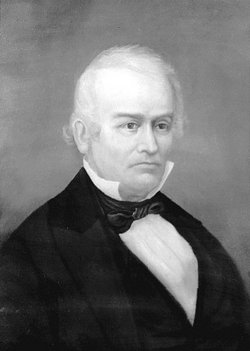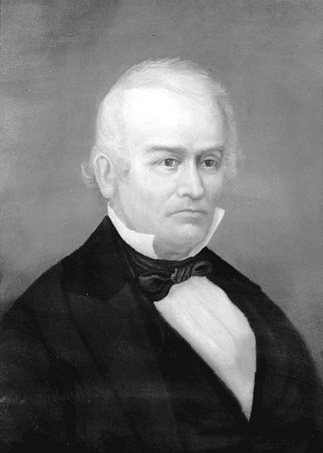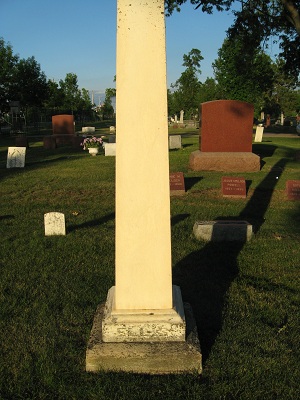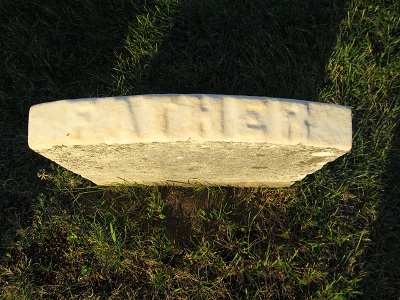"...in 1821 came Albert G. Ellis, eminent among the early educators of the state and later Surveyor General of the territory of Wisconsin. It was fortunate that men of high character and sterling worth, all of whom were
active in promoting the best interests of Brown county, should have been instrumental in its early settlement." pg.86
"In 1823 the Protestant Episcopal Missionary Society established a school in the Agency house on Dutchman's Creek (Town of Ashwaubenon), the Rev. Eleazer Williams having charge and Albert G. Ellis conducting the school. Both white and Indian children seem to have attended this school.
A post school was inaugurated at this period at Fort Howard under the tutelage of A. G. Ellis, in a commodious building furnished with books, stationary and furniture and a "council of administration," with the commanding officer to keep discipline. Some thirty of the citizens' children were admitted. The officer of the day visited the school regularly at three o'clock, and on Friday afternoon General Brady and his staff inspected and heard recitations." pg. 142
"Later at the solicitation of the Green Bay citizens, Ellis opened a school in the Rouse schoolhouse with over eighty scholars. This building was erected by Louis Rouse and stood on the Louis Grignon claim near the present southern limit of Green Bay. About one-half the pupils paid for tuition, to the remainder the benefit of the school was given gratuitously.
The attempt made by the Protestant Episcopal Missionary Society to gather in the little aborigines had from various causes proved a failure, but in 1828 the society sent the Rev. Richard F. Cadle to take charge of the Green Bay mission, who obtained possession of a building in Shantytown known as the officers' quarters of the Camp Smith stockade. Notice was given in November of that year, that the school would open. A. G. Ellis aided in its organization. For some weeks it numbered just one scholar, but the pupils gradually increased in number, and soon the entire confidence of the people was secured.
Possession was obtained from government of a vacant strip of land, about two and a quarter arpents wide, and running back one and a quarter miles to Devil river. This strip had been claimed by Judge Porlier, but was not confirmed to him by the United States commissioners. It was a beautiful site, on high ground overlooking Fox river at its broadest stretch, and is included today in the town of Allouez ; on it buildings were erected, at a cost of $9,000, and in a year and a half, there were nearly two hundred children enrolled and in attendance. Those of pure Indian blood were boarded and clothed as well as instructed free of expense; the half castes paid a small or large proportion of the regular price for board and tuition, according to their means. The charge was $30 annually for boarders, and $2 quarterly for tuition alone. To quote from A. G. Ellis, "the expense account was enormously large, and funds did not come to meet it as they were needed, nor did the results meet expectations, for only a small proportion of the children were natives who could not be induced to attend." (in 1842 the school was disbanded) pgs. 241-242
"The Ellis mills and farm in the town of Preble, the property of Albert G. Ellis, first Surveyor General of Wisconsin, were on Hell creek, which became Hill creek when the newspapers wished to be respectful and polite. There were on this pretty stream a saw and grist mill, a machine shop, two dwelling houses, a barn and a blacksmith's shop, all built by General Ellis and his home was there for many years. It was so far out in the woods that bears roamed in the vicinity of the house, and the pine cut grew directly around the mill. This
was the case with all these early mills." pg. 182
"...in 1821 came Albert G. Ellis, eminent among the early educators of the state and later Surveyor General of the territory of Wisconsin. It was fortunate that men of high character and sterling worth, all of whom were
active in promoting the best interests of Brown county, should have been instrumental in its early settlement." pg.86
"In 1823 the Protestant Episcopal Missionary Society established a school in the Agency house on Dutchman's Creek (Town of Ashwaubenon), the Rev. Eleazer Williams having charge and Albert G. Ellis conducting the school. Both white and Indian children seem to have attended this school.
A post school was inaugurated at this period at Fort Howard under the tutelage of A. G. Ellis, in a commodious building furnished with books, stationary and furniture and a "council of administration," with the commanding officer to keep discipline. Some thirty of the citizens' children were admitted. The officer of the day visited the school regularly at three o'clock, and on Friday afternoon General Brady and his staff inspected and heard recitations." pg. 142
"Later at the solicitation of the Green Bay citizens, Ellis opened a school in the Rouse schoolhouse with over eighty scholars. This building was erected by Louis Rouse and stood on the Louis Grignon claim near the present southern limit of Green Bay. About one-half the pupils paid for tuition, to the remainder the benefit of the school was given gratuitously.
The attempt made by the Protestant Episcopal Missionary Society to gather in the little aborigines had from various causes proved a failure, but in 1828 the society sent the Rev. Richard F. Cadle to take charge of the Green Bay mission, who obtained possession of a building in Shantytown known as the officers' quarters of the Camp Smith stockade. Notice was given in November of that year, that the school would open. A. G. Ellis aided in its organization. For some weeks it numbered just one scholar, but the pupils gradually increased in number, and soon the entire confidence of the people was secured.
Possession was obtained from government of a vacant strip of land, about two and a quarter arpents wide, and running back one and a quarter miles to Devil river. This strip had been claimed by Judge Porlier, but was not confirmed to him by the United States commissioners. It was a beautiful site, on high ground overlooking Fox river at its broadest stretch, and is included today in the town of Allouez ; on it buildings were erected, at a cost of $9,000, and in a year and a half, there were nearly two hundred children enrolled and in attendance. Those of pure Indian blood were boarded and clothed as well as instructed free of expense; the half castes paid a small or large proportion of the regular price for board and tuition, according to their means. The charge was $30 annually for boarders, and $2 quarterly for tuition alone. To quote from A. G. Ellis, "the expense account was enormously large, and funds did not come to meet it as they were needed, nor did the results meet expectations, for only a small proportion of the children were natives who could not be induced to attend." (in 1842 the school was disbanded) pgs. 241-242
"The Ellis mills and farm in the town of Preble, the property of Albert G. Ellis, first Surveyor General of Wisconsin, were on Hell creek, which became Hill creek when the newspapers wished to be respectful and polite. There were on this pretty stream a saw and grist mill, a machine shop, two dwelling houses, a barn and a blacksmith's shop, all built by General Ellis and his home was there for many years. It was so far out in the woods that bears roamed in the vicinity of the house, and the pine cut grew directly around the mill. This
was the case with all these early mills." pg. 182
Family Members
-
![]()
Eleazer Holmes Ellis
1826–1906
-
![]()
Fredrick Seymour Ellis
1830–1879
-
![]()
Richard F. C. Ellis
1832–1881
-
![]()
Virginia Ellis Mooers
1836–1853
-
![]()
Orange R. Ellis
1841–1874
-
![]()
Pamela Holmes Ellis Hogle
1848–1936
-
![]()
Theodore Conkey Ellis
1849–1871
-
![]()
Lora B. Ellis Wadleigh
1852–1937
-
![]()
Candace Ellis
1855–1890
-
![]()
Eliza Ellis
1862–1917
-
![]()
Sophronia Ellis
1864–1881
-
![]()
Albertina Ellis Radtke
1868–1941
Advertisement
Explore more
Sponsored by Ancestry
Advertisement



















